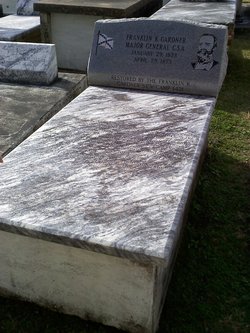
Major General Franklin Gardner
Frank Gardner was born in 1823 in New York City. His father was a lieutenant colonel in the U.S. Army and his mother was from a wealthy Louisiana family. He entered the United States Military Academy at West Point, New York in 1838 and graduated 17th out of 39 cadets in the Class of 1843. His one note of distinction was his ranking of first in his class in drawing which was considered an important subject at the time because of the need to draw fortifications and maps in wartime.
Like his father, Frank married into a wealthy Louisiana family. He married Marie Celeste Mathilde Mouton, the sister of future Confederate Brigadier General Jean Jacques Alfred Alexander Mouton (see my blog http://trrcobb.blogspot.com/2010/12/general-with-long-name-jean-jacques.html). Her father Alexander Mouton would also become the governor of Louisiana.
Following graduation from West Point, he entered military service in the infantry. He would see at least four major battles in the Mexican War and was distinguished twice for gallantry. He served under Albert Sidney Johnston during the Morman Expedition with the rank of captain. When the South seceded from the Union, he never bothered to resign, but simply departed his post in Utah for Louisiana.
He spent the early part of the Civil War bouncing from post to post. He served as a lieutenant colonel of infantry, a staff officer under Jubal Early, commanded a brigade of cavalry, and even saw action at Shiloh. When Beauregard became commander of the Army of Mississippi, he was promoted to brigadier general commanding all the cavalry of the army. Gardner would see action at Perryville in this capacity. Following Perryville, he promoted to major general and sent to the position he would become most famous for holding: Port Hudson.
Although John C. Pemberton and Vicksburg have gained more attention, Port Hudson was just as important as Vicksburg as a fort defending the Mississippi River. While Vicksburg held the northern part of a 200 mile section of the Mississippi, Port Hudson held the southern point. While Pemberton's 33,000 man army was withstanding a siege by Ulysses Grant and his army of 77,000, Frank Gardner was fighting longer odds. His 7,500 men were facing between thirty and forty thousand under Nathaniel Banks.

A Confederate Columbiad at Port Hudson
At Port Hudson, Frank Gardner placed his engineering skills to good work. He strengthened the fort and prepared the defenders for hard fighting. When Banks army arrived, Gardner withstood 47 days of siege and inflicted 5,000 casualties on his enemy. Another 5,000 Union soldiers became casualties to disease during this same period. Gardner's total casualties amounted to almost one thousand men.
He refused to surrender until July 9, 1863 after he was certain that Vicksburg had fallen and that Joseph Johnston wasn't coming to his aide with reinforcements. His men were half starved, been exposed to constant artillery fire for over forty days, had no medical supplies, and were utterly exhausted. He had accomplished far more than most men would have in the same situation.
He remained a prisoner of war until August of 1864 when he was exchanged. Gardner was then sent to command the District of Mississippi and East Louisiana under Richard Taylor. He would see minimal action for the remainder of the war. Following the war, he made a living farming in Lafayette, Louisiana. He would only survive the war by eight years. He died at age fifty of unknown causes. His tombstone lists his middle name as Kitchell, although there are few other sources that show him having a middle name.

Frank Gardner's grave
He rests today in Saint John's Cemetery in Lafayette, Louisiana. His wife Mary would outlive him by almost 42 years. He rests in the same cemetery as his brother-in-law Brigadier General Jean Jacques Alfred Alexander Mouton who was killed at the Battle of Mansfield in 1864.

An image said to be Franklin Gardner, some people believe this is actually a photograph of Confederate Brigadier General Richard Brooke Garnett
(See my blog http://trrcobb.blogspot.com/2011/01/who-is-richard-brooke-garnett.html?showComment=1434653687876#c3561612509051448284)













